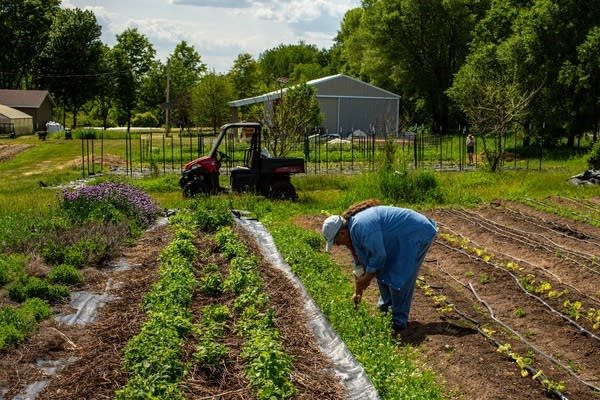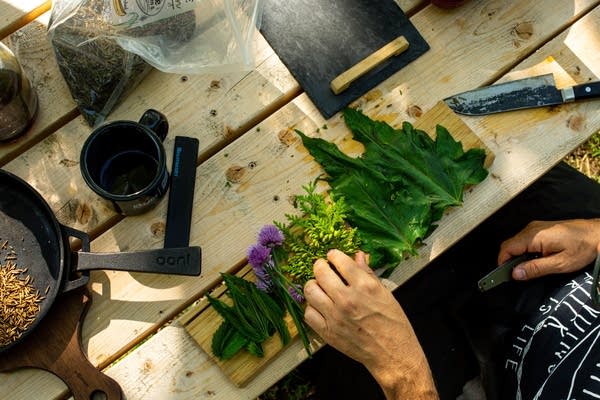Foraged plants form a connection to the earth

Go Deeper.
Create an account or log in to save stories.
Like this?
Thanks for liking this story! We have added it to a list of your favorite stories.
The tall grasses are alive with the sounds of birds and insects at Dream of Wild Health Farm in Hugo, Minn. As one of the few Native-led farms in the Twin Cities, it’s a special place. I’ve come to meet with Hope Flanagan, the community outreach director for the farm, who is a Seneca plant expert and elder. She’s leading me on a plant walk that offers a snapshot of how food might have been gathered by her ancestors as few as a hundred years ago.
Sean Sherman, renowned Lakota chef and owner of the 2022 James Beard best new restaurant Owamni, has joined us on the walk. The two compare notes on what they’re finding and between little nibbles concur that prickly ash tastes like lemon lime, but also a little tingly with a spicy back-edge like black pepper.

As I myself taste, it occurs to me how like themselves these plants taste, rather than the sometimes bland, cardboardy flavor that many commodity produce fruits and vegetables can offer. When I mention this to Hope, she says that yes, it’s a lesson she’s learned from her Ojibwe teachers: eating wild food can impart your spirit with wildness, you don’t want to eat too many of “the enslaved ones,” as she calls cultivated plants.
But before we go too deep into the walk, she introduces herself in the traditional way of her tribe, in both English and Ojibwemowin, making note that it’s important for everyone to be able to hear the introduction, including the plants, animals and insects.
Turn Up Your Support
MPR News helps you turn down the noise and build shared understanding. Turn up your support for this public resource and keep trusted journalism accessible to all.

“Hello all my relatives my fellow living beings, I'm known by the spirits as Little Wind Woman. In English, I'm known as Hope. I am a snapping turtle, currently appearing as a human. I'm from over there,” she points. “The Tonawanda reservation over that way.”
Her first lessons from elders about the uses of the plants around her began when she was two years old, she recalls. Now some six decades on she says she’s still learning, and she carries that expertise, and the responsibilities that go with it, in her name.
“This one elder said, ‘Okay, you got to learn the language, because those plants are going to talk to you. And you got to know what plants they are. And now you're gonna have to carry this name,’” she said.
“So this is where all this responsibility is, when you get your name,” Hope continues. “It's not like, ‘Oh, look at me, I have this name!’ It's now you have this responsibility. And you're going to carry this for the rest of your life. For me, I have to thank these plants every year, go through any plant I've gathered, and thank them and do a food offering and go out to the woods and make sure that they're honored, make sure that I walk in a certain way so that I'm not disrespectful to the plants.”
As we walk, she stoops to pick up leaves and berries, petals and seeds, squishing, sniffing and tasting. With a great laugh she requests that I let her know if she has green things in her teeth, as she often does, she says. She finds lambs quarters, an unassuming leaf shaped a bit like a triangle. It’s incredibly versatile, she tells me, and even higher in nutrition than spinach.
“So this is probably one of those that people will tear out of their garden and throw it away. No! Don't throw it away! Eat it!”

But before she picks anything, she puts down an offering of tobacco, and offers thanks to the ground.
“Don't take anything unless you've got something to give back,” she explains as she points to a leather pouch hanging round her neck. “That's why you'll always see we have our tobacco bags to put something down to say thank you. The understanding is, if we don't thank them, they're just going to leave us and those are our teachers, those are our elders. What are we going to do then?”
Because Hope says she’s not much of a cook, Sean has offered to do the culinary portion of this meal. Much of the menu at Owamni, as well as the chef’s entire culinary ethos, is based in part on opening your eyes to what plant diversity can be gathered outdoors in any part of the world.

“We’re hoping that we're enticing people to get interested in not only being creative and cooking with these flavors and creating new recipes, but also just being curious to be outdoors to create that connection with the world and the plants and to learn the stories which we can pass down,” he explains.
But as we get curious and creative, Hope offers constant reminders of the gravity of what we’re up to today.
“Every single plant has a gift of food, utility, medicine and then the green ones have the gift of breath,” Hope says. “So they have so much more to give than we have, in our way of thinking. In the stories, you'll hear that these are elders. They were here before us. They don't need us. We need them.”

In her Indigenous tradition, she tells me, the life of plants goes beyond the function of food, or even medicine. They are woven into language and guide how people speak about the world.
“They're living beings. And that's what's so different when you're talking in the language. You can't think about any of this as not being living because the sentence structure changes when you talk about things that aren't living versus things that are living.”
In Ojibwemowin, she says, there were originally not any nouns, because things don’t matter in that tradition. Living beings, and our relationships to them, do.
Once we’ve gathered a sufficient handful of edible plants, we return to Sean’s induction burner set up on a picnic table in the field. He starts puffing wild rice in a pan, softening nettles and flavoring cooking liquid with the cedar and bergamot that we’ve foraged, sweetening it all with pure maple that he’s brought along.

“The Western diet in the United States has rarely taken into account all this amazing stuff,” he explains, pushing the mixture around in the pan with the back of his chef’s knife.
“And so we're just showcasing that Indigenous peoples really hold such a wonderful key to living more sustainably utilizing a lot more of this knowledge. And people like Hope, who has so much of this wisdom, and is happy to share this wisdom, is just a great example of helping to spread this for future generations.”
In a few moments, the dish is finished. He quickly gathers the mixture in a cup plant leaf to form a green wrap about the size and shape of a sushi roll. He places it on a wooden platter, and garnishes it with purple chive flowers. I waste no time digging in.

The flavors are intense, and easily identifiable individually. I get a hit of vegetal from the cup plant that holds the entirety of the bite together. Then, a tiny bit of bitterness from the cedar, and earth from the wild rice. The maple adds a pleasant sweet and sticky finish. Purple chive flowers are both oniony and floral. It’s like a whole world in your mouth.
“You can taste your entire walk,” Sean laughs.
Later, he confesses that he was nervous because he forgot to bring salt, but I didn’t even notice its absence.

But deliciousness aside, Sean and Hope reminds us that there is, truly, a whole world of knowledge in that little green wrapper.
“It’s that connection to the world, it's that connection to the plants, that creates that connection to our ancestors directly, because we can share that knowledge just like our ancestors did not that long ago,” Sean emphasizes.
“You know, because it’s less than 100 years ago that so many of our ancestors still carried so much of that knowledge in them. And so much of that knowledge was being wiped away this past century. So it's really important that we do everything we can to steward this knowledge moving forward,” he concludes, while plating the rest of the contents of the pan.
“We're just part of a community,” Hope adds as a reminder. “We're just members of a community of all this life. That's it, we're no better, we're no worse. We have to treat each other as living beings.”



